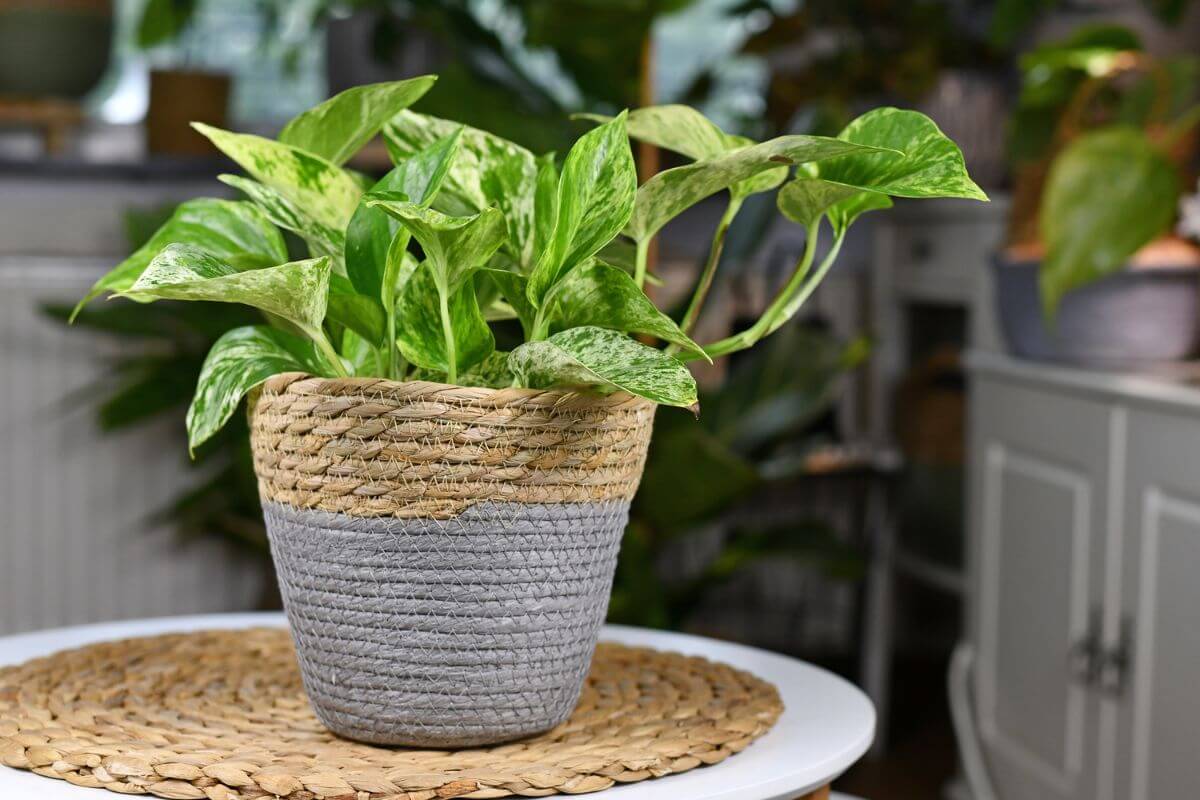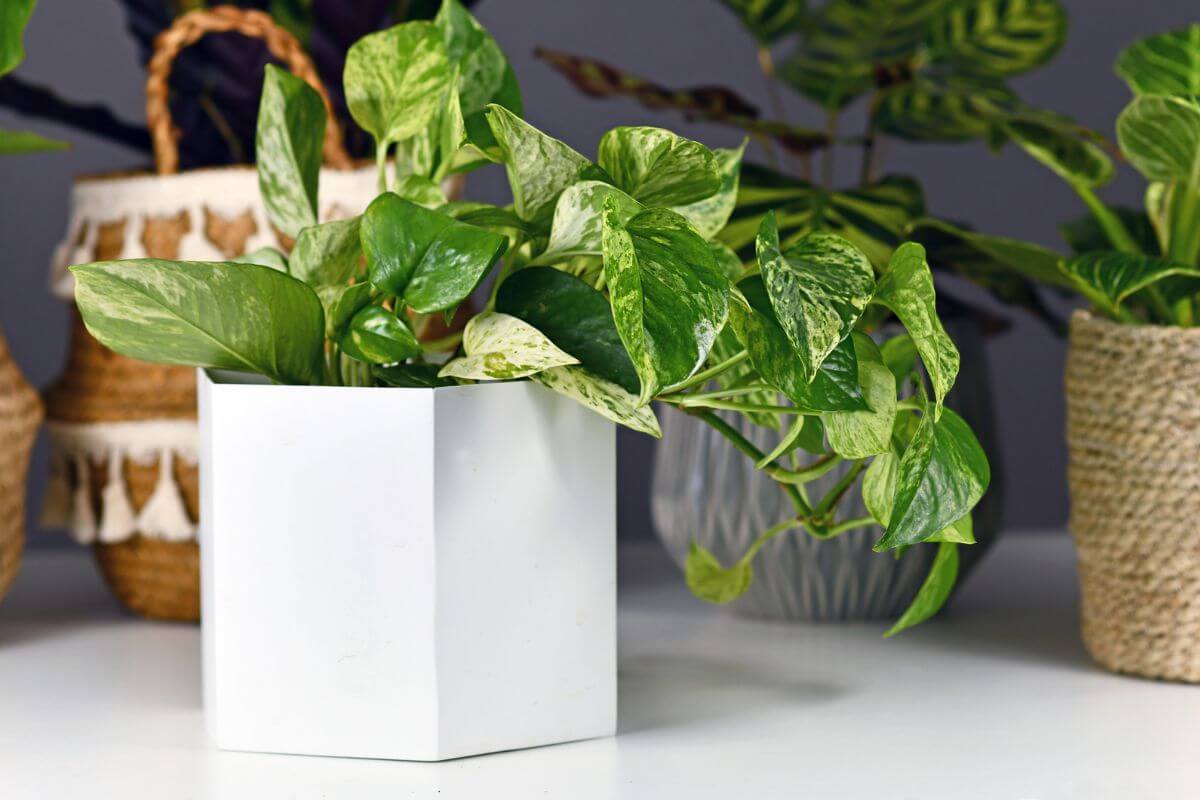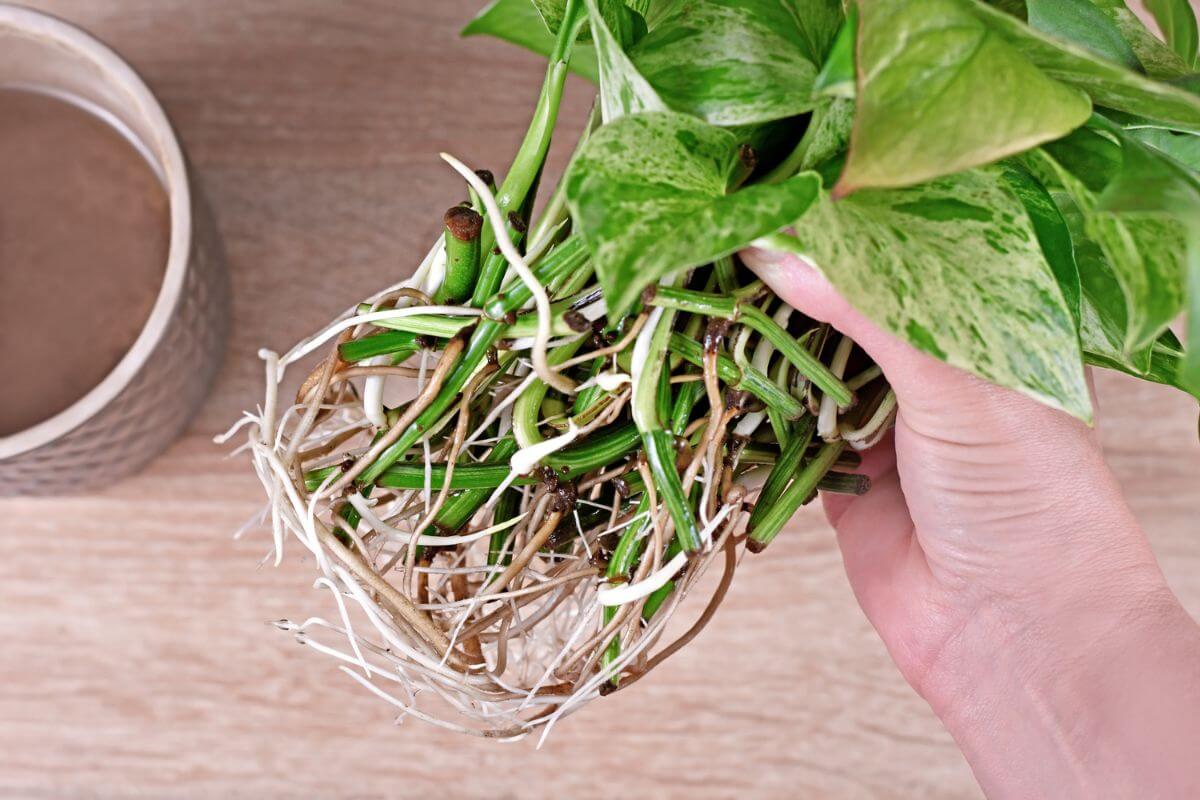I’ve been growing a variety of pothos plants for years. They’re easy to grow, inexpensive, and they look gorgeous in any home. Pothos plants are beautiful and versatile houseplants, but they also require care and attention.
One of my favorite varieties is the Marble Queen Pothos for their beautiful, variegated leaves. The marble queen is a striking plant to grow at home or in an office.
This guide will cover how to care for the marble queen pothos, and keep them alive and thriving.
Marble Queen Pothos Overview

The Pothos royalty or Marble Queen Pothos is an incredibly popular member of the Epipremnum aureum family. This pothos variety has lovely and unique variegation, which explains its popularity as indoor plants.
Whether you have your marble queen climb up a pole or trellis, or cascade down from a basket, she will make a stunning addition to your décor. She can also be cultivated as a tabletop plant or in a terrarium.
This tropical plant beauty is native to rainforests in the South Pacific. As a vining plant, they are fast growers. Like all pothos cultivars, the marble queen is hardy and seemingly indestructible.
Marble Queen Pothos Care Guide
Soil for the Marble Queen Pothos
The marble queen pothos can be grown in soil or water.
If growing in soil, it likes well-aerated soil, so a loose chunky potting soil will be good. You can add in some orchid bark, coco coir, or perlite to the potting soil for better drainage and aeration.
The marble queen can also be cultivated in water. It needs water and nutrients to continue thriving as well.
Temperature for the Marble Queen Pothos
Your marble queen will prefer warmer temperatures as it’s a tropical plant from the rainforest.
Temperatures ranging between 60° and 90° Fahrenheit will be ideal. A constant temp at 70°F will encourage growth.
Light for the Marble Queen Pothos

While the general rule for most indoor houseplants is generous bright indirect light, the marble queen pothos is pretty adaptable.
As a rainforest plant, they naturally grow in the shade under natural canopies of trees and large plants. This means that the marble queen will be able to thrive in a wide range of lighting conditions, including low light and limited direct sunlight exposure.
You can choose a spot that has some direct morning sun, but indirect light for the rest of the day. Too much sunlight exposure can cause leaf tips to brown and become crispy.
In a colder climate, especially during the winter, these pothos plants can sit right on your windowsill.
If you place it in a low-light environment, do pay attention to its growth and variegation. Too little light can lead to stunted growth and cause your marble queen leaves to be less “marbly” due to less variegation. It’ll turn into solid green leaves.
Water for the Marble Queen Pothos
Any member of the pothos family should not be left standing in water as this will inevitably lead to root rot. If the marble queen’s foliage is yellowing, check the soil bed for overwatering.
The marble queen pothos should always be in a pot that has a sufficient number of drainage holes, allowing for excess water to drain away and saving your plant from literally drowning.
A good method for watering your pothos is to soak it in a sink and then let the excess water drain out of the bottom before returning it to its regular spot.
To check when it is time to water, poke your finger a couple of inches into the soil bed. If the soil feels dry, it’s time to water. Should you forget to water, don’t worry, because the marble queen is drought tolerant.
However, if the leaves start to droop, you need to give the plant water immediately. Tap water isn’t ideal. Filtered water or rainwater is better for the plant as there is less chance of chemicals and minerals.
Humidity for the Marble Queen Pothos
The marble queen pothos likes humidity, so an average humidity level somewhere between 60 and 95% should keep it happy. This is one of the reasons that pothos are often grown successfully inside terrariums.
While your plant may enjoy misting on a regular basis, it will not resolve a lack of humidity in the environment.
Mist doesn’t act as a substitute for humidity long term. It will raise the humidity temporarily, but nothing more.
Humidifiers, pebble trays, a nearby water receptacle, and grouping plants together can aid in increasing humidity.
Fertilizer for the Marble Queen Pothos
A liquid houseplant fertilizer is good for nourishing your marble queen. It can be fertilized monthly or bi-monthly during the growing season from March through September.
During the winter and its dormancy period, dilute the fertilizer to half strength.
Repotting the Marble Queen Pothos

When the marble queen becomes rootbound, it’s time to repot. You may start seeing roots coming out of the soil surface or the pot’s drainage holes.
When choosing to repot, it is better to repot it during the growing season. Choose a new pot that is one size larger than the current one.
Pruning the Marble Queen Pothos
While the marble queen is a showpiece plant in a terrarium, it’s also an aggressive grower. It will require regular pruning or it will quickly outgrow the terrarium. It may be better positioned in a large-sized terrarium.
If you want a fuller tabletop plant, be sure to trim them regularly to encourage bushier growth.
Even if you prefer to encourage vining with the marble queen, you’ll still want to trim back stem tips to promote fuller growth.
The stems can grow to ten feet long or more when indoors. Outdoors, they can reach seventy feet easily.
Propagating the Marble Queen Pothos
To propagate using stem cuttings. Select a healthy vine and make sure to cut a stem section with at least one leaf just beneath the leaf node.
Place it in water and wait for the roots to develop. When the new roots measure a couple of inches, you can place your new plant in potting soil.
Marble Queen Pothos Toxicity and Pets
Unfortunately, the marble queen pothos contains calcium oxalate crystals and is toxic to cats and dogs. Be sure to call your veterinarian if think your pet has ingested any part of the marble queen plant.
Marble Queen Pothos Problems and Pests

While the marble queen pothos is a hardy plant, there are a few problems to keep an eye out for.
- Green Leaves – If variegated leaves lose their variegation and become greener, it is usually due to too little light, meaning they are struggling to complete photosynthesis. In this case, move the plant to a brighter location for more natural light.
- Brown leaves or leaf tips – Brown leaf tips and leaves indicate that the pothos is receiving too much sun. Excessive sun exposure leads to the scorching of foliage. Again, change the location of your plant. Brown foliage can also indicate that humidity levels are too low.
- Yellowing leaves – Yellow leaves can indicate lots of things, but the most common reason is overwatering. Check your plant for sufficient drainage.
- Dark patches or blotches on foliage – This may indicate that the environment is too cold for your plant.
- Common Pests – Typical houseplant pests such as aphids, mealybugs, and thrips can be treated with organic insecticidal soap or with neem oil.
Clean the marble queen leaves gently once every few weeks. Use a damp cloth to remove dust and dirt from its leaves.
Wiping the leaves will help plants take up carbon dioxide from the air for use in creating energy and growing healthily.
Marble Queen Pothos Care Final Thoughts
The marble queen pothos is a wonderful indoor plant. With proper care, it can live for years indoors. The best way to ensure the longevity of your plant is by providing it with the proper care.
Here are other varieties of pothos that many people like to grow:
Marble Queen Pothos Care FAQs
How big do Marble Queen pothos get?
The marble queen pothos can grow up to 10 feet or more when indoors. Outdoors in their native environment, they can grow up to 70 feet long. Its leaves can grow to more than 3 feet long in some cases.
The stems can grow to ten feet long or more when indoors. Outdoors, they can reach seventy feet easily.
Where should I keep my Marble Queen pothos?
Keep your marble queen pothos in an area with bright indirect sunlight and has higher humidity levels. Bathrooms and kitchens are great places as these areas of the home usually have good, natural light and humidity.
Does the Marble Queen grow slower than other pothos?
The Marble Queen grows more slowly in comparison to other pothos plants. However, it is still a great plant for indoor environments. It has beautiful green, variegated foliage, but they also contain less chlorophyll. That can slow photosynthesis, resulting in slower growth.
Do Marble Queen pothos like to be misted?
Yes, marble queen pothos prefer misting for short-term relief of a lack of humidity, especially when it’s dry and hot. Simply use a spray bottle filled with water and mist your plants daily or weekly.
How often should you water Marble Queen pothos?
Water Marble Queen Pothos once a week, and be careful not to overwater them. Overwatering causes roots rot, which may kill the plant. The soil can dry differently in various areas, so be sure to always check the soil for how quickly it dries in your area.
Why are Marble Queen pothos leaves turning yellow?
The marble queen pothos leaves are turning yellow because of overwatering and soggy soil. Water only when the top couple inches of soil feel dry. Be sure the pot container has good drainage holes and are not clogged.
Why are variegated Marble Queen pothos leaves turning green?
Variegated marble queen pothos leaves turn green when they receive too little light. There’s not enough light for it to complete the photosynthesis process for its white variegated leaves. To keep your plants healthy, give them bright indirect light.
Why are my Marble Queen pothos leaves brown?
Brown leaves on the marble queen pothos plant indicate it may be suffering from too much direct light exposure. You’ll want to move the plant away from the direct sunlight and in an area with partial shade.


